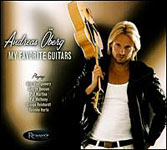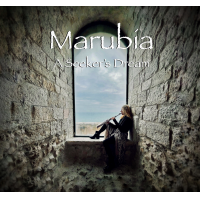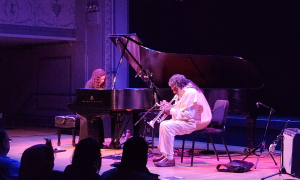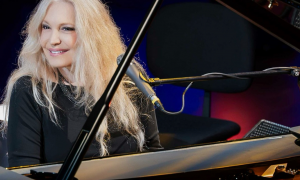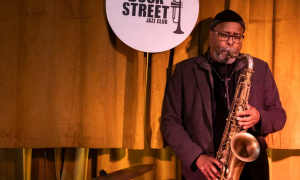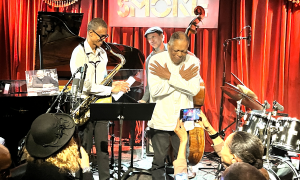Home » Jazz Articles » Live Review » Sidney Bechet Society Concert with Evan Christopher, NYC
Sidney Bechet Society Concert with Evan Christopher, NYC
...think Samba mixed with Tango spiced with a Rumba moving forward as it sways back and forth at the same time.
Thalia Theater, Symphony Space
New York City
September 15, 2008

It is unusual for the clarinet, the smallest and hardest-to hear-instrument in a jazz ensemble, to be in the forefront. But Evan Christopher has brought the musical stick front and center in the various sized ensembles he has led in New Orleans and Paris.
Sidney Bechet, one of jazz history's most forceful clarinetists, had few rivals and was an innovator equal to trumpeter Louis Armstrong, who stood out in any recording he made, especially in the 1920s and 1930s on the tunes Bechet wrote in New Orleans or New York and later in Paris, where he became a national sensation. Evan Christopher's travels have followed a similar path as Bechet's from California to New Orleans to New York to Paris and, yesterday, to New Orleans for this concert.
Christopher brought with him a fascination with musicians who espoused the indigenous rhythms of the Caribbean Islands of Martinique, Dominica, Guadeloupe and the city of New Orleans, places where the music's originators combined African and Spanish rhythms with French dance forms—all influences on Christopher's own clarinet style. A striking example was "Follow the Second Line," a Christopher composition that encompasses the rhythms of the islands and New Orleans sans dancers (think Samba mixed with Tango spiced with a Rumba moving forward as it sways back and forth at the same time). Influenced by Christopher's jazz studies, the tune evoked "Swing," much like that of the Artie Shaw Orchestra's hit recording of Cole Porter's "Begin the Beguine," which eschews the beguine rhythm altogether.
It was in pre-War II Paris, when expatriate American musicians encountered Caribbean Creoles and gypsy guitarist Django Reinhardt, that the music commingled as it also had in New Orleans fifty years earlier. Examples from Christopher's most recent CD Django a la Creole (Lejazzetal, 2008) are "Douce Ambience" and a New Orleans favorite, "Farewell Blues."
The opening number, "Flee as a Bird," segued into a must-play jazz standard for any aspiring clarinetists: "High Society." It was primarily a duet with Jon-Eric Kellso leading on cornet with Christopher's clarinet doubling the rhythm in the lowest register then rising as they continued. With steady support from acoustic rhythm guitarist Pete Smith, amplified electric guitarist Matt Munisteri and bassist Sebastien Girardot, the commingling of rhythms became obvious. ""When two world-famous New Orleans musicians Sidney Bechet and Jelly Roll Morton reunited here, 'New York City Storyville' was the first tune they recorded," Christopher explained in his opening remarks. Another Morton creation, named for jazz legendary progenitor in pre-1910 New Orleans and called "Buddy Bolden's Blues," found Kellso's plunger- muted cornet/trumpet softly talking Bolden's melody originally titled "Funky Butt." Matt Munisteri's solo modernized the rhythm with a country and electric guitar influence while retaining the melody as Sebastien Girardot unobtrusively provided support on a borrowed bass fiddle.
Jelly Roll Morton wrote "Maminita" with a rhythm he called a "Spanish Tinge," meaning he incorporated a Cuban habanera rhythm that he possibly absorbed while observing a dance in his travels to Mexico. Tonight Christopher recreated that rhythm on clarinet, and from the New Orleans Rhythm Kings' repertoire his small group recreated Django's recording of "Farewell Blues," which originally included alto saxophonist Benny Carter. Taken at a medium fast tempo it allowed Munisteri and Christopher to stretch out, then inject the train whistle strain just before the cornet and clarinet duet until the end.
As an introduction to "Low Cotton" Christopher warned this audience of classic jazz fans, "We're not going to play it the same way as the recording, but it's important to me that Barney Bigard (the renowned clarinetist who was from an old Algiers, New Orleans family and who stayed with Ellington and Armstrong for 20 years each), is included." Played at a relaxed tempo, and as written by Rex Stewart, it was very advanced for its time. Pete Smith's solo nicely evoked the acoustic guitar sound of the Hot Club of France. With a beret draped over the bell of Kellso's cornet/trumpet he created soft, mellow tones recognizable to 78 rpm record collectors as a tone Bix Beiderbecke adapted from listening to French impressionist composers.
The first recording of one of New Orleans' foremost clarinetists, Jimmy Noone, was cut in Chicago in 1928. With Joe Poston on alto sax and clarinet, the record impressed many musicians for the two reed men's ability to play harmonic runs together. The same was true of Kellso and Christopher, but in addition the clarinetist infused his arpeggios with a Caribbean syncopation. It's an art that fell out of favor as New Orleans "jass" spread up the Mississippi River, throughout South and Midwest, on Steamboats that Louie Armstrong eventually brought to New York.
The evening concluded with two excellent originals. Jon-Eric Kellso's "Blue Roof Blues," a funeral dirge for Katrina, that the clarinet morphed into a lovely, romantic and uplifting melody. Christopher's aforementioned "Follow the Second Line" was the perfect finishing touch to an inspired evening that bodes well for the continued creation of a modern yet authentic New Orleans jazz.
Photo Credit Daniel Kassell
Tags
PREVIOUS / NEXT
Support All About Jazz
 All About Jazz has been a pillar of jazz since 1995, championing it as an art form and, more importantly, supporting the musicians who make it. Our enduring commitment has made "AAJ" one of the most culturally important websites of its kind, read by hundreds of thousands of fans, musicians and industry figures every month.
All About Jazz has been a pillar of jazz since 1995, championing it as an art form and, more importantly, supporting the musicians who make it. Our enduring commitment has made "AAJ" one of the most culturally important websites of its kind, read by hundreds of thousands of fans, musicians and industry figures every month.



